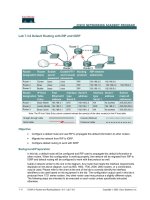Lecture Web technology and online services: Lesson 7.1 - ReactJs
Bạn đang xem bản rút gọn của tài liệu. Xem và tải ngay bản đầy đủ của tài liệu tại đây (465.16 KB, 33 trang )
ReactJs
1
Content
Overview of ReactJS
Virtual DOM
JSX
Components
React Component Lifecycle
Overview of ReactJS
3
Overview of ReactJS
•
React(also known as React.js or ReactJS) is an open-source, front end, JavaScript library for
building user interfaces or UI components
•
•
It maintained by Facebook and a community of individual developers and companies
React was created by Jordan Walke, a software engineer at Facebook, who released an
early prototype of React called "FaxJS“. It was first deployed on Facebook's News Feed in
2011 and later on Instagram in 2012.
•
On September 26, 2017, React 16.0 was released to the public.
•
On February 16, 2019, React 16.8 was released to the public.
•
On August 10, 2020, the React team announced the first release candidate for React v17.0, notable
as the first major release without major changes to the React developer-facing API
Virtual DOM
5
Virtual DOM
What is DOM?
• The Document Object Model (DOM) is a cross-platform and language-independent
interface that treats an XML or HTML document as a tree structure wherein each node
is an object representing a part of the document.
•
•
⇒
The DOM represents a document with a logical tree.
Each branch of the tree ends in a node, and each node contains objects. DOM methods
allow programmatic access to the tree; with them one can change the structure, style or
content of a document.
In React, Virtual DOM exists which is like a lightweight copy of the actual DOM
•
•
every object that exists in the original DOM there is an object for that in React Virtual DOM
Manipulating DOM is slow, but manipulating Virtual DOM is fast as nothing gets drawn on the
6
screen.
How Virtual DOM helps React?
•
Each time we change something in our JSX file, all the objects that are there in the
virtual DOM gets updated.
•
React maintains two Virtual DOM at each time, one contains the updated Virtual DOM
and one which is just the pre-update version of this updated Virtual DOM.
•
Now it compares the pre-update version with the updated Virtual DOM and figures out
what exactly has changed in the DOM. This process is known as ‘diffing’
•
Once React finds out what exactly has changed then it updated those objects only, on
real DOM. This significantly improves the performance and is the main reason why
Virtual DOM is much loved by developers all around.
7
8
JSX
9
JSX
•
•
JSX = Javascript + XML
•
React uses JSX for templating instead of regular JavaScript => but, It is not necessary
to use it
•
however, following are some pros that come with it.
JSX, or JavaScript XML, is an extension to the JavaScript language syntax. Similar in
appearance to HTML, JSX provides a way to structure component rendering using
syntax familiar to many developers
•
•
•
It is faster because it performs optimization while compiling code to JavaScript.
It is also type-safe and most of the errors can be caught during compilation.
It makes it easier and faster to write templates, if you are familiar with HTML.
10
JSX
import React from 'react';
JSX looks like a regular HTML in most
cases.
class App extends React.Component {
render() {
return (
<div>
Hello World!!!
</div>
);
}
}
export default App;
11
JSX - Nested Elements
import React from 'react';
If we want to return more elements, we need to
wrap it with one container element.
class App extends React.Component {
render() {
return (
<div>
Header
Content
This is the content!!!
</div>
);
}
}
export default App;
12
JSX - Attributes
import React from 'react';
class App extends React.Component {
render() {
return (
<div>
Header
Content
This is the content!!!
</div>
);
}
}
export default App;
We can use our own custom
attributes in addition to regular HTML
properties and attributes
13
JSX - JavaScript Expressions
import React from 'react';
class App extends React.Component {
render() {
return (
<div>
{1+1}
</div>
);
}
}
export default App;
JavaScript expressions can be used inside of
JSX. We just need to wrap it with curly
brackets {}
14
JSX - Styling
import React from 'react';
class App extends React.Component {
render() {
var myStyle = {
fontSize: 100,
color: '#FF0000'
}
return (
<div>
Header
</div>
);
}
}
export default App;
React recommends using inline styles.
15
Components
16
Components
17
Components
• Components are independent and reusable bits of code. They serve the same
purpose as JavaScript functions, but work in isolation and return HTML via a render()
function.
• Components come in two types:
• Class component
• Function component
18
Function Component
•
Functional components are declared with a function that then returns some JSX.
19
Class Component
•
Class-based components are declared using ES6 classes.
20
Differences between Functional Components and Class Components
Functional Components
Class Components
A functional component is just a plain JavaScript function that
accepts props as an argument and returns a React element.
A class component requires you to extend from React.
Component and create a render function which returns a React
element.
There is no render method used in functional components.
It must have the render() method returning HTML
Also known as Stateless components as they simply accept
data and display them in some form , that is they are mainly
responsible for rendering UI.
Also known as Stateful components because they implement
logic and state.
React lifecycle methods (for example, componentDidMount)
cannot be used in functional components.
React lifecycle methods can be used inside class components
(for example, componentDidMount).
21
Component - props
•
•
•
•
•
Props is what you pass into the Component via attributes
Props is only way to input data(Or you can use Redux)
Props are immutable
Container component will define data that can be changed
Child Component will received data from parent component via props
22
Component - props
import React from 'react';
class App extends React.Component{
render(){
return(
<div>
{this.props.headerProp}
</div>
);
}
}
import React from 'react';
import ReactDOM from 'react-dom';
import App from './App.jsx';
ReactDOM.render(
<App headerProp="Header from props" />
document.getElementById('app')
);
export default App;
export default App;
23
Component - State
• Private data of component
• When state change => re-render component
• Can’t read from outside Component
24
Component - State
class Car extends React.Component {
constructor(props) {
super(props);
this.state = {brand: "Ford"};
}
render() {
return (
<div>
My Car
</div>
);
}
}
25









